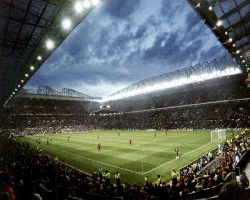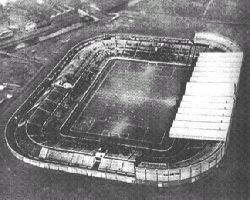Diposting oleh
sRaMaNcHuNia
di
12.08
Old Trafford began life on Archibald Leith's drawing board. The Scotsman was renowned for designing some of the best football stadia, so, when Manchester United needed a new stadium to be built in 1908, he was the man they approached. It was built in 1909, and contained some three sides of terracing, and a covered seating area.
 Old Trafford was such a great stadium when it was built that it hosted several FA Cup finals, and became one of the most famous stadiums in England. A reporter for the Sporting Chronicle (February 19th 1910) even went so far as to describe it as "The most handsomest, the most spacious and the most remarkable arena I have ever seen. As a football ground it is unrivalled in the world, it is an honour to Manchester and the home of a team who can do wonders when they are so disposed"
Old Trafford was such a great stadium when it was built that it hosted several FA Cup finals, and became one of the most famous stadiums in England. A reporter for the Sporting Chronicle (February 19th 1910) even went so far as to describe it as "The most handsomest, the most spacious and the most remarkable arena I have ever seen. As a football ground it is unrivalled in the world, it is an honour to Manchester and the home of a team who can do wonders when they are so disposed"
Even today, it is regularly used by the English Football Association to host FA Cup semi-finals, not to mention the odd prestigious UEFA European Champions League final! Old Trafford also staged several games during the European Championships in 1996 when England had the pleasure of hosting the event.
The stadium was bombed during the wars, and United had to share a home with their great local rivals Manchester City for several years until Old Trafford was restored to its full glory.
Throughout the ages, Old Trafford has developed. The record attendance of 76,962 people was set in 1939, and, up until the late 1980's, crowds of 58,000 people were regularly down at Old Trafford on Saturday afternoons.
 The Hillsborough disaster, however, lead to the infamous anti-hooligan laws in England. Though United were the first team to install a perimeter fence to counter hooliganism in the 1970's, the notion of an all-seater stadium was still not approved by every frequenter of the ground. The capacity of Old Trafford in 1993 was as low as 44,000.
The Hillsborough disaster, however, lead to the infamous anti-hooligan laws in England. Though United were the first team to install a perimeter fence to counter hooliganism in the 1970's, the notion of an all-seater stadium was still not approved by every frequenter of the ground. The capacity of Old Trafford in 1993 was as low as 44,000.
Since then, Manchester United PLC have built up the ground impressively. Over a period of five or six years they have rebuilt or renovated three sides of the ground, taking the capacity to just over 68,000 making it the biggest stadium in English league football, and, with the demise of Wembley, currently the biggest stadium in the country.
As many English fans will tell you, all-seater stadia have taken something from the atmosphere of league football. The old Stretford End at Old Trafford was once monitored for noise levels, and was proven to make more noise than a jumbo jet taking off! Though the atmosphere is not quite so electric today, United are trying to improve the level of noise by introducing "singing areas" around the ground.
The final - South - side of the ground is all that needs to be redeveloped, and,when it's done, it will increase the capacity of the stadium to a whopping 90,000 seated fans. That's on a par to the capacity of the Maracana stadium in Brazil, and about the same number that's planned for the new Wembley.
 Even with just 68,000 fans, Old Trafford is a very impressive stadium, and one that leads the way in modern stadia design. It was christened "The Theatre of Dreams" by Sir Bobby Charlton in the 1960's, and the name has stuck with the stadium - particularly as sometimes the football played on the hallowed turf there has been simply unbelievable.
Even with just 68,000 fans, Old Trafford is a very impressive stadium, and one that leads the way in modern stadia design. It was christened "The Theatre of Dreams" by Sir Bobby Charlton in the 1960's, and the name has stuck with the stadium - particularly as sometimes the football played on the hallowed turf there has been simply unbelievable.
Old Trafford will remain a true crowd-puller for many years to come on match-days, and simply in attracting tourists to the stadium tour or to the café's or mega-store that reside within the stadium complex.
Plans were announced in June 2004 to expand the stadium capacity to over 75,000, and building work began at the end of the 04/05 season. By December 2005 the stadium was regularly selling out to 75,000 fans.
Credit: Cristianoronaldo7.com


0 komentar:
Posting Komentar